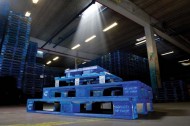 In 2013 pallet pooling specialists CHEP plans to continue its strategy of finding ways to simplify the “last mile” of the supply chain which – although short in distance – accounts for some 65% of the total supply chain cost. Research conducted by CHEP in 2011 on the supply chains of 41 retailers in seven European countries identified that 24 different packaging formats and 55 different packaging product platforms are currently in use in this crucial ”last mile”.
In 2013 pallet pooling specialists CHEP plans to continue its strategy of finding ways to simplify the “last mile” of the supply chain which – although short in distance – accounts for some 65% of the total supply chain cost. Research conducted by CHEP in 2011 on the supply chains of 41 retailers in seven European countries identified that 24 different packaging formats and 55 different packaging product platforms are currently in use in this crucial ”last mile”.
A customer forum facilitated by CHEP was attended by executives from companies such as Britvic, Coca-Cola, Heinz and Nestle, and examined ways of tackling the mushrooming complexities in the last mile. In some sectors, bespoke and non-industry standard packaging and handling solutions have been introduced as businesses strive to reduce costs and increase efficiencies, This, in turn, has led to suppliers having to increase the different ways products are packed and delivered.
“CHEP is at the heart of the supply chain and so ideally placed to see both the changes that are taking place and to share ideas as to how these final stages can be simplified,” said John Kenna, Director Market & Customer Insight at CHEP EMEA. “This part of the supply chain is changing fast. We feel that through collaboration and offering innovative solutions which can be integrated into our equipment pooling model it will help our customers adopt simpler procedures.”
According to CHEP, a key issue is that “last mile” logistics is at different stages of development across Europe. In some countries – such as Greece and Italy – full-sized 1208 pallets are still used which are then unloaded by hand at the retailer and the products are manually put on the shelves. Whilst in Germany and Spain, smaller, fractional pallets – of which the 600 x 800 is the most popular choice – are being increasingly utilised to take goods in retail ready packaging directly on to the shop floor where they can act as gondola ends and merchandising units.
“This complexity obviously puts added pressure on a manufacturer as several retail customers may be taking the same product but require them on different pallet formats, resulting in multiple SKUs for what is essentially the same product,” added John. “Frequently, full-sized pallets have to be broken down into smaller units which entail further handling, so adding delay and cost to the process. CHEP can influence this drive towards increased standardisation due to its existing pan-European networks.”
CHEP




Comments are closed.